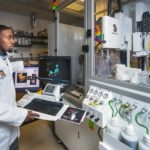DOWNERS GROVE, Ill., Dec. 8, 2014 — Students and teachers may not always see eye-to-eye, but they’re in agreement when it comes to technology in the classroom: more is better, according to new research published today by CompTIA, the information technology (IT) industry association.
Overwhelmingly, students in grades K through 12 believe technology makes learning more interesting and more fun, CompTIA’s The Changing Classroom: Perspectives from Students and Educators on the Role of Technology study reveals.
Three-quarters of educators see positive or very positive effects of technology when applied to the education process. This includes in the classroom as well as better communication and collaboration with parents and other teachers.
Even more notable, 96 percent of millennial teachers – those younger than 34 years old – believe that technology is important in the classroom.
Preparing for Careers
Beyond the day-to-day classroom work, educators and students also recognize the importance of developing technology skills early to ensure students are prepared to enter an increasingly digital workforce. Nine in 10 students say the use of technology in the classroom will be important in helping them get jobs.
“For some it’s difficult to grasp just how quickly the digitization of the workplace is occurring,” said Carolyn April, senior director, industry analysis, CompTIA. “Even occupations that may seem far removed from tech-intense jobs may now have a significant technology component.”
While most students rate their skill level with technology as average or above, they also cite a number of skills that they would like to learn more about while in school. These include:
– Gaming simulations (cited by 52 percent of students)
– Computer troubleshooting (49 percent)
– Programming/coding (45 percent)
– Apps for audio and music making (43 percent)
– Mobile apps (43 percent)
“The rating for computing troubleshooting is especially interesting given that this is an area of technology that receives far less attention than most of the other categories on the list,” noted Anna Matthai, manager, research and market Intelligence, CompTIA.
The CompTIA report also includes some cautionary notes on roadblocks to wider use of technology in the schools, with financial considerations topping the list. Students also recognize the limits of technology in school. Approximately one in three says it’s very true that technology can be a distraction when used excessively. An additional 49 percent of students believe it is somewhat true.
“When technology is so accessible it’s almost too easy to jump between productive and non-productive uses,” Matthai said.
CompTIA’s The Changing Classroom: Perspectives from Students and Educators on the Role of Technology is based on two online surveys conducted in September 2014. In one, 400 U.S. educators and administrators in the K-12 sector surveyed; in the second, 1,000 middle school and high school students were questioned.
The complete report is available at www.comptia.org/insight-tools.











